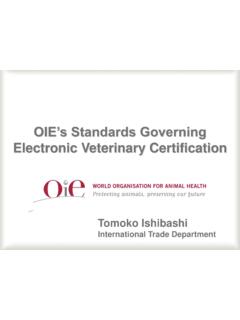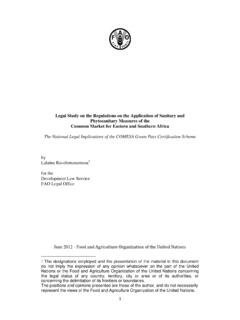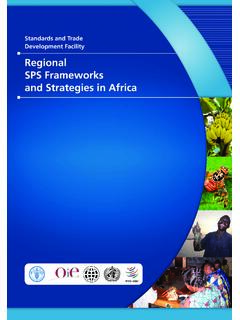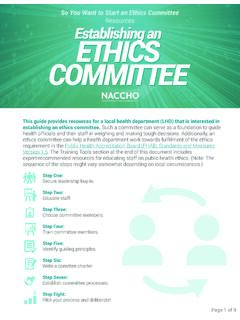Transcription of GUIDE TO GOOD MANUFACTURING PRACTICE (GMP) …
1 GUIDE TO. good MANUFACTURING PRACTICE (GMP). REQUIREMENTS FOR CINNAMON PROCESSORS. '. GUIDE to good MANUFACTURING PRACTICE (GMP). Requirements for Cinnamon Processors Author Dr. Eresha Mendis ( ). Food safety consultant for UNIDO. Senior lecturer Department of Food Science and Technology Faculty of Agriculture University of Peradeniya Year of Publication - 2016. This Book was published by the United Nations Industrial Development Organization (UNIDO). jointly with The Spice Council (TSC) of Sri Lanka and Funded by Standards and Trade Development Facility (STDF). ISBN 978-955-3959-01-0. GUIDE to good MANUFACTURING PRACTICE (GMP). Requirements for Cinnamon Processors Contents Page The scope of this booklet 05. The importance of food safety in the local and international food trade 06.
2 The role of food safety standards and certification in ensuring food safety 08. GMP standard as a foundation for food safety management 10. The relevance of GMP standard for the Sri Lankan cinnamon industry 10. The good MANUFACTURING practices (GMP) required to be established in cinnamon processing to ensure compliance to the standard (1) Establishment: Design and facilities (A) Location 12. (B) Building and cinnamon handling areas 13. (C) Equipment and utensils 14. (D) Facilities 15. (2) Hygienic processing requirements (A) Raw material requirements 19. (B) Prevention of cross contamination 20. (C) Supervision of processing 21. (D) Packaging 21. (E) Storage of processed cinnamon (end product) 22. (F) Transport of the end product 22. (G) Sampling and laboratory control procedures 23.
3 (H) Documentation and records 23. (3) Establishment of hygiene requirements (A) Maintenance 24. (B) Hygiene control program 24. (C) By-products 25. (D) Storage and disposal of waste 25. 03. GUIDE to good MANUFACTURING PRACTICE (GMP). Requirements for Cinnamon Processors (E) Exclusion of domestic animals 26. (F) Pest control 26. (4) Personal hygiene and health requirements (A) Medical examination of communicable diseases and injuries 27. (B) Personal behavior 28. (C) Visitors 29. (5) Product information and documentation (A) Product information and recall procedures 30. (B) Lot identification and labeling 30. (C) Documentation and records 31. (6) Training 31. (7) Primary production 32. How to use the SLSI GMP standard to ensure conformity to GMP.
4 Requirements in a cinnamon processing unit and obtain GMP certification 33. Future directions 35. 04. GUIDE to good MANUFACTURING PRACTICE (GMP). Requirements for Cinnamon Processors The scope of this booklet The Sri Lankan food industry is growing and the number of food manufacturers involved in food processing has increased over the years. Parallel to this expansion in the sector, a higher attention is paid by the regulatory authorities to enforce food safety aiming to promote local and global food trade. In this context, food hygiene PRACTICE in food establishments has made mandatory from the year 2012 and all employees who process, transport, distribute, handle, store or sale of food are expected to be aware of the principles of food hygiene to lay the foundation for food safety in food establishments.
5 These hygiene requirements are also common to spice processing industry. Being the main producer of cinnamon to the world, a greater emphasis is needed to be paid to establish them in cinnamon industry, for Sri Lanka to remain as the main competitor in the world market. This booklet provides guidance on practical aspects of developing, implementing, and maintaining good MANUFACTURING practices (GMP) within a cinnamon processing facility to protect cinnamon from chemical, microbiological and physical contaminations. Requirements highlighted in this booklet can be followed by the interested parties involved in cinnamon processing to obtain compliance to GMP. Development of this booklet was funded by United Nations Industrial Development Organization (UNIDO) and Standards and Trade Development Facility (STDF) under the UNIDO-WTO-TSC cinnamon project.
6 This Project is managed by The Spice Council ( TSC) of Sri Lanka. 05. GUIDE to good MANUFACTURING PRACTICE (GMP). Requirements for Cinnamon Processors The importance of food safety in the local and international food trade Safe food describes a food, which is free from hazards and thus such food will not cause any harm or injury to the consumer when it is eaten flowing the given instructions. Hazards are biological, chemical or physical in nature and, are harmful agents that can contaminate food at any point of the food chain leading to foodborne illnesses. In the food trade, safety of food is identified at domestic, regional and international levels as a public health priority, as unsafe food causes illness in millions of people every year and result in many deaths all over the world.
7 According to the World Health Organization, serious outbreaks of foodborne disease have been reported in every continent in the past decade and, in many countries the rates of related illnesses are increasing significantly. There are many reasons that food pose threat to human life and, the key global food safety concerns include spreading of microbiological hazards, presence of chemical food contaminants, and hazards resulting from new food technologies (such as genetically modified food) and thus a great emphasis is placed on strong food safety systems in most countries to ensure safety in local and global food chains. According to the reports of public health authorities , industrialized countries have been facing with an increasing number of food safety problems in the past two decades and illnesses due to contaminated food are perhaps the most widespread health problem in the contemporary world and an important cause of reduced economic productivity.
8 The situation is equally or more serious in developing countries, where infant diarrhea causes many illnesses and deaths. In addition to known foodborne diseases, public health communities are being challenged by the emergence of new or newly recognized types of foodborne illnesses, often with serious and chronic health consequences. Certain populations (Eg. pregnant women, the elderly, infants and children, immunocompromised persons, and the under- nourished) are particularly more vulnerable to food safety issues. In economic terms, foodborne illnesses are very costly for the industry, health services, and society as a whole and, many factors contribute to the increase in foodborne diseases globally. Industrialization, leading to increased wealth and urbanization, has revolutionized the food supply system, resulting in mass 06.
9 GUIDE to good MANUFACTURING PRACTICE (GMP). Requirements for Cinnamon Processors production and an explosive increase in the number of food service establishments and food outlets. Mass production, environmental factors, and inadequate knowledge of the food handlers have contributed to increased contamination of primary foodstuffs. The multinational approach to food production and distribution and the progressive opening up of world markets have allowed the international food trade to flourish. The globalization of food (and feed) trade, facilitated by the liberalization of world trade, while offering many benefits and opportunities, also presents new food safety risks. Because, infectious agents can be disseminated from the original point of processing and packaging to locations thousands of miles away.
10 The globalization of foodborne diseases also results from increased travel. A. person can be exposed to a foodborne illness in one country and expose others to the infection in a location thousands of miles from the original source of the infection. Food safety in the present context represents a transnational challenge requiring enhanced levels of international cooperation in setting standards and regulations and in strengthening surveillance systems. Simultaneously, consumers are becoming increasingly concerned over food quality and safety requirements. Such concerns have now been articulated via higher quality and safety standards required by markets, with producers under greater pressure to meet such standards in their efforts to build consumers' confidence.









